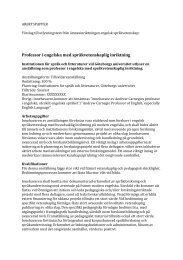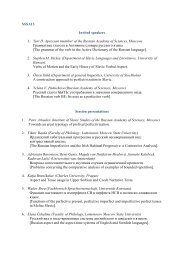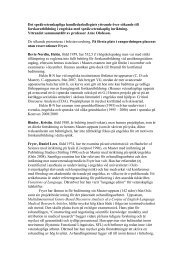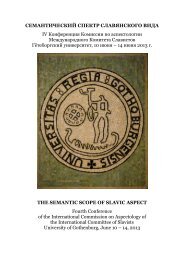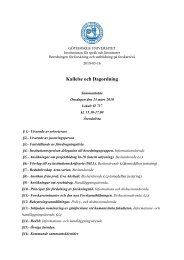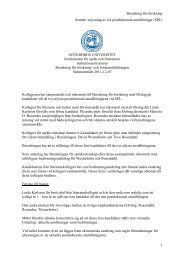Ensemble, and the Moscow Pan-Asian Ensemble. The Yoshida Brothers, who clearly combine Japanesetraditional music with various global popular music styles, appear to be the only of thesefour bands to have already been thoroughly researched. Tokyo Brass Style seemed an attractivechoice because it entails a hybrid of western brass band and contemporary Japanese youth culture.I am already well-acquainted with members of the ensemble from Finland, and performedas a member of the ensemble from Russia, so familiarity and accessibility also naturally influencedthe selection of these examples.Yoshida BrothersThe Yoshida Brothers are a renowned popular music act from Hokkaido consisting of brothersRyoichiro Yoshida (b. 1977) and Kenichi Yoshida (b. 1979), who play the tsugaru-shamisen.Interestingly, the brothers first gained enormous fame throughout Japan and the USA largely dueto an appearance performing their song “Kodo (Inside the Sun Remix)” in a 2007 television commercialfor the Nintendo Wii videogame system. The Yoshida Brothers official website explainstheir meteoric rise to fame as follows:“Each picked up the shamisen at the tender age of five, and began studying Tsugaru shamisenunder Takashi Sasaki I in 1990. After sweeping prizes at national Tsugaru shamisen conventions,the brothers made their major debut in 1999. The debut album sold over 100,000 copies,which is an extraordinary figure for a traditional folk music release. They won the “TraditionalJapanese Music Album Of The Year” category of the 15th annual Japan Gold Disc Award, as wellas the “30th Anniversary Of Normalization Of Japan-China Diplomatic Relations CommemorativeSpecial Prize” of the 17th Annual Japan Gold Disc Award.” 27The historic roots of such tsugaru shamisen music have been thoroughly researched, whichhas not proceeded without controversy since much of the original sources appear to be unreliable.The Yoshida Brothers received extensive training in the tsugaru shamisen tradition, butlater decided to take their music in a new direction. Although some performances of the YoshidaBrothers may legitimately qualify as “traditional Japanese music,” much of their music is clearlyinfluenced by rock and other popular music styles, notably including their hit “Rising,” whicheven contains heavy metal elements. On their MySpace website, the Yoshida Brothers are describedas “Japan’s young masters of the ancient tsugaru-shamisen” and we are told that theirnew album Prism “reflects their long-standing commitment to traditional Japanese folk music,refracted through modern musical sensibilities, incorporating elements of pop, rock, and worldmusic sounds.” The website also boldly declares that the Yoshida Brothers have “taken the tsugaru-shamisenfurther than any other modern musician, practically reinventing its sound, leadingto a musical style both firmly rooted in the traditions of the past and boldly looking forward tothe future.” The Yoshida Brothers MySpace website offers many quotations that laud the uniquenessof their artistic achievement. One quotation credits The Globalist for describing the YoshidaBrothers as “an example of how music, though it can bend, does not break with tradition. Thehistory and tradition that echoes through their sound proves that even the most global music isrooted in local soil.” Another quotation attributed to Jon Parales of the New York Times asserts“Their set, like a shredding heavy-metal solo was all about speed and twang.” The Boston Globereportedly claims that “The brothers embrace tradition, playing standards from the shamisen27 Yoshida Brothers, official website, http://www.domo.com/yoshidabrothers/<strong>Cultural</strong> translation and Music31
shamisen repertoire. But they also expand on it. In their own compositions, they riff onthemes from the old songs, incorporating other instruments and elements from jazz,repertoire. classical, But flamenco, they also rock, expand the on blues it. In even their own techno. compositions, The music they is high riff on energy, themes and from it the isold highly songs, improvisational.” incorporating other Such instruments statements and from elements an array from jazz, of sources classical, are flamenco, strategically rock, the usedblues by Yoshida even techno. Brothers The music and their is high management energy, and it as is highly a form improvisational.” of online self-representation,Such statementsfrom suggesting an array that of sources their work are strategically remains connected used by Yoshida to Japanese Brothers traditional and their management music despite as a someovertly commercial qualities. In other words, the Yoshida Brothers have attempted toform of online self-representation, suggesting that their work remains connected to Japanese“translate” the essence of their traditional music into the familiar idiom of popular musictraditional music despite some overtly commercial qualities. In other words, the Yoshida Brothershave attempted to “translate” the essence of their music into the familiar idiom ofpreferred by young people today both in Japan and abroad. Their music, thereby,“remains in an ambiguous position” between traditional, folk and popular genres. 30 Thepopular proposed music model preferred could by be young applied people to the today high-profile both in Japan case and of abroad. the Yoshida Their music, Brothers thereby, as“remains demonstrated in an ambiguous below: position” between traditional, folk and popular genres. The proposedmodel could be applied to the high-profile case of the Yoshida Brothers as demonstrated below:32Pentagonal Analysis of <strong>Cultural</strong> Translation (PACT)Musical Example: Yoshida Brothers<strong>Cultural</strong> Origins: Japanese Folk Music / Global Popular Music (techno,heavy metal, etc.)Specific Domain:A) Technological Adaptations StrongSalience ofHybridity:[ Strong / Med / Weak ]Figure 3: PACT-Yoshida BrothersExplanation/Evidence:Japanese shamisen with heavy-metal style guitar effects and technodance backing tracks.B) Idiomatic Conventions Medium Familiar popular music style accompaniment“Phantasm” or “flavor”? Syncretism of modern pop styles withC) Aesthetic Notions Weakhistorical musical practices.D) Creative Practices Weak Little evidence of new approaches.E) Receptive Contexts Strong TV advertising for videogames: new marketing approach.Figure 3: PACT-Yoshida BrothersMinna Padilla and the Helsinki Koto EnsembleAnother very interesting musician who merits some discussion is Ms. Minna Padilla, a FinnishMinna koto player Padilla and and leader the of Helsinki the Helsinki Koto Koto Ensemble, who agreed to an interview for theAnother very interesting musician who merits some discussion is Ms. Minna Padilla, apurposes of this research (on 10 February, 2011). One year earlier, in February of 2010, a crewFinnish koto player and leader of the Helsinki Koto Ensemble, who agreed to anfrom TV Tokyo had traveled to Helsinki to interview Minna for its show “Japan All Stars.” Theinterview for the purposes of this research (on 10 February, 2011). One year earlier, increw filmed her performing and teaching koto to children, and rehearsing with the Helsinki KotoFebruary of 2010, a crew from TV Tokyo had traveled to Helsinki to interview Minna forEnsemble. its show They “Japan also All interviewed Stars.” The Minna crew about filmed her her compositions, performing studies, and teaching and concerts koto in to Japan,as children, well as innovative and rehearsing techniques with for the koto Helsinki playing. Koto As Minna Ensemble. recalls, “The They film also crew interviewed said they were Minnaimpressed about her by compositions, my music when studies, they heard and The concerts Helsinki Koto Japan, Ensemble as well playing, as innovative and that techniquesit wasgreat for koto see playing. koto used As with Minna this kind recalls, of music “The group.” film crew Nowadays, said they Minna were maintains impressed a busy by performancemusic schedule when they as leader heard of The the Helsinki Koto Koto Ensemble, Ensemble with playing, concerts and in Japan that it and was at various great to seemyfestivals koto used and with embassy-affiliated this kind of music events group.” in Europe. Nowadays, 28 Typically billed Minna as maintains “Minna Padilla a busy and the HelsinkiKoto Ensemble,” these Finnish musicians perform original semi-improvisatory folk music30 See Michael S. Peluse, “Not your grandfather’s music: Tsugaru shamisen blurs the lines between folk,compositions traditional and that pop,” are Asian largely Music, inspired 32(2), by 57-80 Japanese (2005), music p. 76. and Peluse’s culture article yet also is a robust have roots previous in con- study thatfocuses on the Yoshida Brothers; however, there appear to be no previous studies of Helsinki KotoEnsemble, Tokyo Brass Style, and Moscow Pan-Asian Ensemble.28 MySpace: Minna Padilla, Helsinki Koto Ensemble, http://www.myspace.com/minnapadillathehelsinkikotoensemble14David G. Hebert
- Page 1: Cultural TranslationsProceedings of
- Page 4 and 5: PrefaceThe idea of organizing a wor
- Page 6 and 7: ContentsAcknowledgementIIPrefaceIII
- Page 8 and 9: Literature and Transculturality:Som
- Page 10 and 11: agenda of Herder, which was to figh
- Page 12 and 13: nomenon. However, until long into t
- Page 14 and 15: Tawada’s work appeared in Swedish
- Page 16 and 17: multiple interpretations. Japan is
- Page 18 and 19: Cultural Translation between Tradit
- Page 20 and 21: George P. Murdock illustrated the p
- Page 22 and 23: ancestor of the Maori arrived in Ao
- Page 24 and 25: nal names do not necessarily have.
- Page 26 and 27: One of the functions of ‘cultural
- Page 28 and 29: PRELUDEIn 2003, an original artisti
- Page 30 and 31: planted, adopted and fused with ind
- Page 32 and 33: liest known written clues regarding
- Page 34 and 35: since there are many Asians and Pac
- Page 36 and 37: listening to and evaluating sounds
- Page 40 and 41: temporary Finnish folk music. 29I a
- Page 42 and 43: Although some space for improvisati
- Page 44 and 45: whom have devoted many years to ser
- Page 46: POSTLUDEBy way of conclusion, allow
- Page 49 and 50: IntroductionThe aim of this paper i
- Page 51 and 52: to discuss what role Japan was to p
- Page 53 and 54: I may be allowed henceforth to use
- Page 55 and 56: program was to promote and help stu
- Page 57 and 58: 50different of that of Millán -Ast
- Page 59 and 60: most impracticable people in the ea
- Page 61 and 62: intending to give the Book a quasi
- Page 63 and 64: understood by the West on a time wh
- Page 65 and 66: FUJIWARA Masahiko. (2008) Kokka no
- Page 67: - (2002) Cultural light, political
- Page 70 and 71: Translation, or better, linguistic
- Page 72 and 73: one may not expect anything other t
- Page 74 and 75: as Murakami opts for a globalized v
- Page 76 and 77: market. 17 Another indispensable to
- Page 78 and 79: (This is part of my doctoral thesis
- Page 80 and 81: elieve advances man’s progress he
- Page 82 and 83: ender the New Testament into Japane
- Page 84 and 85: a synonym for kami. The latter is a
- Page 86 and 87: The American school text is in the
- Page 88 and 89:
Willson Reader 46 T73 47I will not
- Page 90 and 91:
Gentlzer, Edwin & Tymoczko, Maria 2
- Page 92 and 93:
Tea ceremony or tea cult?Translatin
- Page 94 and 95:
Company (VOC), men came from differ
- Page 96 and 97:
H. Stolpe gathered items in Japan f
- Page 98 and 99:
simple presentations had negative i
- Page 100 and 101:
theticism, with its manifold bearin
- Page 102 and 103:
Kumakura, Isao (1980) 近 代 茶
- Page 104 and 105:
1. Introduction and aim of the pape
- Page 106 and 107:
main character and the caller doesn
- Page 108 and 109:
not” and ”at present” that ha
- Page 110 and 111:
match this name, a sea as artificia
- Page 112 and 113:
I John Gabriel BorkmanHenrik Ibsen
- Page 114 and 115:
his dream during the 1870s, when ca
- Page 116 and 117:
make a decision. But it turns out t
- Page 118 and 119:
Ôgai’s change of translation str
- Page 120 and 121:
Behind every utterance lies two mot
- Page 122 and 123:
a large group of persons be gathere
- Page 124 and 125:
The “Territory of Translation”
- Page 126 and 127:
八 十 日 間 世 界 一 周 :
- Page 128 and 129:
heuristic tools, especially conside
- Page 130 and 131:
Left: Photo of Kawashima Chūnosuke
- Page 132 and 133:
Burlington Gardens is in London (Ro
- Page 134 and 135:
門 アリ 入 リテ 見 レバ
- Page 136 and 137:
scene seems to be merely one of man
- Page 138 and 139:
Niwa Jun’ichirō’s Spring Tale
- Page 140 and 141:
The text is full of detailed descri
- Page 142 and 143:
where the narrative voice does not
- Page 144 and 145:
The reason the “territory of tran
- Page 146 and 147:
Translating the Trip Around the Wor
- Page 148 and 149:
ForwordI have been working on my do
- Page 150 and 151:
clining though. By the end of 1980
- Page 152 and 153:
幸 い 神 の 怒 りは 鎮 ま
- Page 154 and 155:
The Public Sphere as Deliberation o
- Page 156 and 157:
and absence of hierarchy would have
- Page 158 and 159:
was used much like we would use “
- Page 160 and 161:
outcasts and bandits - were suppose
- Page 162 and 163:
cal sense, the arena where particip
- Page 164 and 165:
society” and in which “there wa
- Page 166 and 167:
sic formulations, the public sphere
- Page 168 and 169:
はじめに日 本 統 治 下 の
- Page 170 and 171:
似 地 一 下 一 下 拽 那 鼻
- Page 172 and 173:
ということから、 古 丁
- Page 174 and 175:
の「 序 」で、 大 東 亜
- Page 176 and 177:
3.1 翻 訳 と 満 洲 国 語 政
- Page 178 and 179:
取 り 入 れを 主 張 する
- Page 180 and 181:
文 化 の 翻 訳 としての「
- Page 182 and 183:
史 性 にも 留 意 すべきだ
- Page 184 and 185:
て、 渦 巻 きよりほかは
- Page 186 and 187:
変 わらないということも
- Page 188 and 189:
訳 語 と 新 語 から 見 る
- Page 190 and 191:
しは「 無 為 」や「 本 性
- Page 192 and 193:
思 想 を 基 礎 として、
- Page 194 and 195:
って「 物 理 上 哲 学 」
- Page 196 and 197:
し、まさにはこの 時 期
- Page 198 and 199:
意 譯 : 理 學 、 性傅 汛
- Page 200 and 201:
柴 田 昌『 增 補 訂 正 英
- Page 202 and 203:
一 八 七 七 年 、 文 部 省
- Page 204 and 205:
日 中 友 好 の 象 徴 「 鑑
- Page 206 and 207:
と 指 摘 した。成 吉 思
- Page 208 and 209:
をあげている。さらにま
- Page 210 and 211:
に 請 ひて 出 家 を 求 む
- Page 212 and 213:
この 時 奉 請 の 十 師 等
- Page 214 and 215:
歴 史 小 説 『 天 平 の 甍
- Page 216 and 217:
点 」が 生 じたと 指 摘
- Page 218 and 219:
まず、 昨 今 、 活 発 に
- Page 220 and 221:
2、 従 来 の 比 較 文 学 (c
- Page 222 and 223:
普 遍 理 論 を 適 用 し、
- Page 224 and 225:
ス・テグネル(Esaias Tegnér,
- Page 226 and 227:
に 満 ちる「 生 命 」に
- Page 228 and 229:
う 形 をとって 展 開 した
- Page 230:
学 が 大 学 で 展 開 して



